
April 2011
John Vincent Bellezza
This month’s Flight of the Khyung changes tack slightly to offer you ancient Tibetan writings on both paper and stone. I think you will find the story about the origins of gold and beer delightful reading, not to mention its cultural historical value. The engraved stones featured afterwards are among the rarest forms of writing discovered in Tibet. Also, you may want to have another look at last October’s newsletter. A new supplemental piece at the end of it discusses the dating of human remains found in an Upper Tibetan burial. That it belongs to circa the 3rd century CE has important cultural and historical implications for the development of civilization in the region.
Drink to your heart’s content: The mythic origins and poetry of libations in ancient Tibet
In 2006, a cache of ancient texts was discovered in a chorten (stupa) in southern Tibet. Known as the Gathang Bumpa (Dga’-thang ’bum-pa) collection, these manuscripts have proven to be one of the most valuable Tibetan textual finds in a century. Written in the Old Tibetan language, I estimate on grammatical and paleographic grounds that these texts were composed between circa 850 and 1000 CE. I have published a translation of one of these texts (Revue d’Etudes Tibétaines, no. 19), the tale of the first ransom offerings for gods and men. In a forthcoming monograph, I present other manuscripts of Gathang Bumpa as well.
One of the most attractive accounts in the Gathang Bumpa collection furnishes the origins of gold and beer, a combination of which produces the traditional Tibet libation known as serkyem (gser-skyems). This is a standard offering in the Tibetan ritual tradition today, as it was many centuries ago. This tale of libations occupies two folios and is presented here it is in its entirety as an English translation. While it contains a paean for beer, this frank account does not shy away from the negative effects of consuming too much alcohol. After describing the joys and travails of beer drinking, the text regales us with the origins and attributes of gold. Upon revealing the allure of beer and gold in all their glory, the text praises them in tandem, in their form as golden libations. This offering par excellence is presented to the celestial deities and terrestrial spirits in an act of propitiation and concord:
In the origins tale of serkyem: The grandfather of beer (chang) was called Namkhun Dingwa (Gnam-’khun ding-ba). The grandmother of beer was called Sakhun Ngamwa (Sa-khun rngam-ba). The father and patriarch was called Lhachu Ngamwa (Lha-chu rngam-ba). The mother and matriarch was called Mu-chu Dingwa (Rmu-chu ding-ba). The sons of their coupling in the season are the nine begotten beer brothers. They are the combined essence of grain, the most excellent of all foods.
When [beer] touches the lips, there is the consciousness of self-awareness. When it touches the tongue, it makes the six types of living beings cleverer. When it falls inside the body, it increases emotional suffering. When it warms the forehead, it makes one more audacious. It perfects the life circumstances of the clever. With it the ignorant attain the consummation of speech. [It makes one] open-hearted, so they can give away the country and castle. It takes the blood money of the man and the blood money of the horse (this signifies that excessive beer consumption can lead to murder, theft and punishment). Beer has qualities such as these.
Gold has qualities like these: The grandfather of gold was Garpo Shele (Dgar-po shel-le) and the grandmother of gold was Che-ma Deldro (Uniform Warm Sand, Bye-ma bdal-dro). The name of the father and patriarch was Zangshoe Serpo Chen (Bzang-shod gser-po chen). The name of the mother and matriarch was Tonggyi Chituema (Stong gyi spyi btud-ma). The son of the mating of these two in the season is the pretty gold, the pure gold, Linglaji (Brling-la-ji).
[The son] is stable and heavy, so he can infiltrate everywhere. He is soft and malleable, so he is compatible with all other things. He is able to transform all desires, so he is the emanation body (sprul-pa’i sku, a magical manifestation). He can inscribe letters on fine cloth (dar) and can display many miracles. He does not fear water or moisture, so he is the best of jewels and treasures. He possesses all colors, so he is the great possession of all the principalities.
That known as gold is the best of jewels and treasures. That known as beer is the cause of all propagations. When beer and gold are combined, their color is brighter than the sun and moon. They are more magnificent and beautiful than Rirab (the World Mountain). They are more splendid than the earth. They are also more profound than the ocean. [To whom] are they offered and presented? They are presented to the mighty gods (lha) and spirits (dre = ’dre) of the four continents of the world. Please accept this golden libation. Do not be capricious or angry. The golden libations origin tale is completed.
This above story is followed by six lines of secret mantras directed to an archaic class of deities known as sad. These spirits are still known in Western Himalayan regions such as Lahoul in Himachal Pradesh.

No. 1

No. 2

No. 3
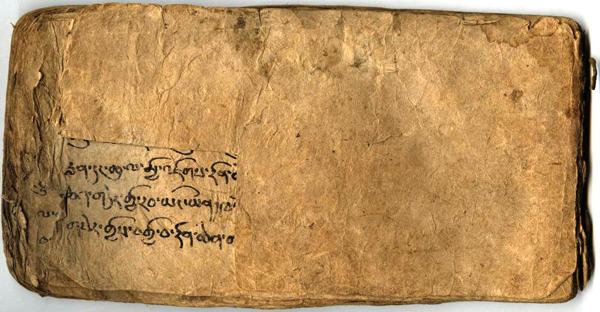
No. 4
The most ancient carvings of letters discovered on stone slabs in Tibet
Over many years of survey work, I have come upon three sites that boast some of the earliest known letters carved on rocks in Tibet. These slabs of rock are popularly referred to as ‘mani stones’ by foreigners, after a popular mantra. This is the six- or seven-syllable ejaculation for the Bodhisattva of Compassion, Chenresik (Om ma ni pad me hung hri). Tibetans have been carving mantras, prayers and deities on chunks of stones and installing these stones on specially built masonry walls (the so-called mani walls) for many centuries. The examples I share with you below are mostly dated to the early historic period (650–1000 CE). Rather than exhibiting the more refined technique commonly used in later times, where the rock surface is removed from around the letters (relief carving), these are reverse carved (intaglio). That is to say, the engraved lines are the strokes of the letters themselves.
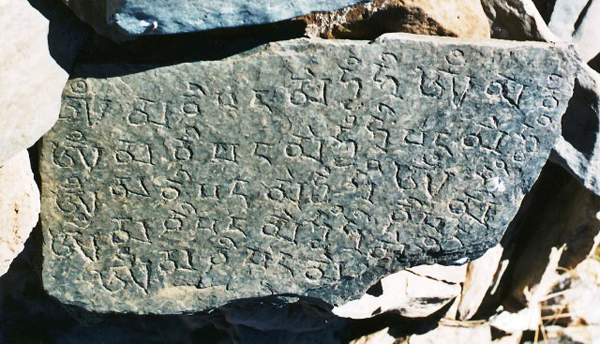
Fig. 1
This slab of rock was carved with the seven-syllable (the final one is the heart syllable hri) variety of the mani mantra. This inscription and others at the site appear to date to Tibet’s imperium, the most ancient examples of mani stones to have surfaced in Tibet. The unusual formation of the letters and the location of these stones at the site of an all-stone corbelled religious center, indicate that these carvings may well date to Tibet’s imperium (629–846 CE). On the right half of the rock five of these mantras appear in horizontal rows. Two more mani mantras have been squeezed on the left side of the stone; the letters written haphazardly, as is often the case in early historic inscriptions. An extremely unusual paleographic feature of the inscription is the inverted u vowel sign (shab-kyu) subjoined to the letter h in the syllable hung. Also of special note is the manner in which the o vowel sign (na-ro) is combined with the ma consonant above the letter A in some of the Om syllables, another archaic trait.
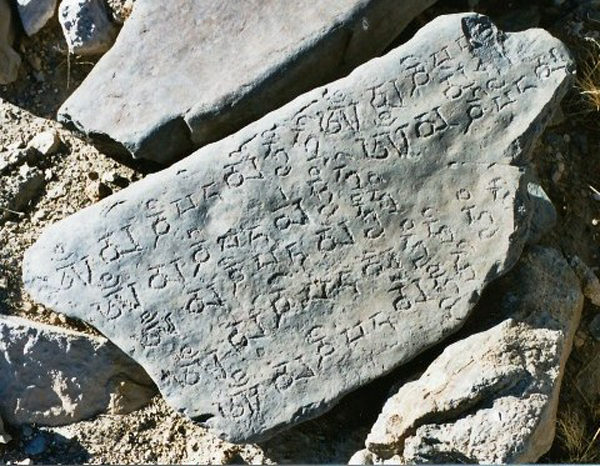
Fig. 2
Another mani stone at the same site as the specimen in fig. 1. This inscription exhibits the same set of paleographic characteristics and line orientation as its counterpart. These and other mani stones of this type at the site constitute epigraphic evidence for the existence of Buddhism and the cult of Chenresik in western Tibet during the first diffusion period.
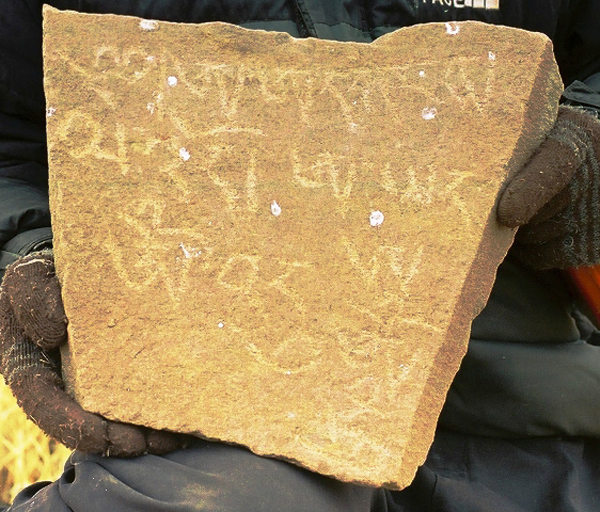
Fig. 3
This Bon inscription reads: Om A dkar sa le ’od / A yang Om ’du (/) A Om hung. This is the Bon mantra of the primordial Buddha, Kuntu Sangpo (Kun-tu bzang-po). The letters of this inscription are well formed and quite conventional in style. As this stone slab is found at an extremely remote and long abandoned site associated with the adept Nangzher Loepo (Nang-bzher lod-po), it is tempting to date it to the 8th century CE, but it could possibly have been made one or two centuries later. Even more speculative but that much more appealing is to suggest that it was carved by the hand of the Dzokchen (Great Perfection) master Nangzher Loepo himself. This is the only engraved stone at the site, adding to its sanctity and cultural historical value. If indeed it dates to the period of Nangzher Loepo, it demonstrates that the Bon vehicle of Dzokchen was indeed practiced in Upper Tibet during the imperial period.

Fig. 4
One of a pile of ancient carved stones belonging to the Bonpo at an early cultural stronghold. This inscription also consists of the mantra of Kuntu Sangpo, but in its longer and more modern form. The letters were clearly written in a standard manner, suggesting that this inscription can be attributed to a later period. I estimate that it was produced circa 1000–1250 CE.
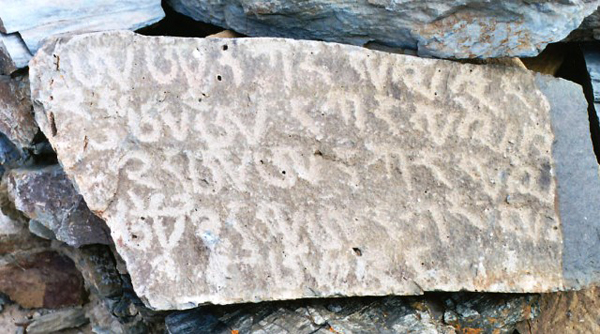
Fig. 5
On this stone the shorter version of the Kuntu Sangpo mantra has been cut four times. However, the edges of this stone have broken off or worn away rendering the mantras incomplete. It is found at the same site as the carved stone in fig. 4, but it appears to significantly predate it. On the basis of the style of calligraphy and the abbreviated or precursory form of the mantra presented, this inscription can possibly be attributed to the imperial period.
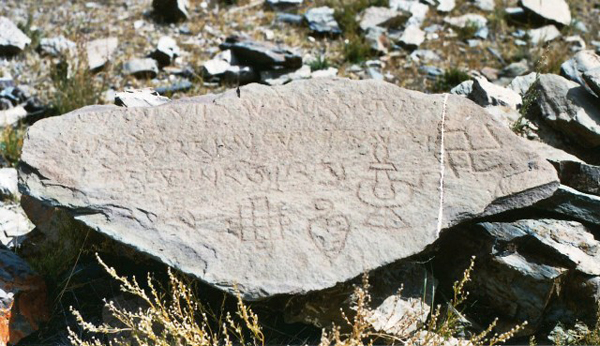
Fig. 6
This carved stone belongs to the same site as do the specimens in figs. 4 and 5. In addition to featuring the mantra of the primordial Buddha Kuntu Sangpo, a number of icons were engraved on this rock. From left to right, they include the counterclockwise swastika, vase, (?), and endless knot. Further to the right is part of a circular design but most it has disappeared with the breakage of the stone. As to the identity of the heart-shaped motif, I am at a loss. This inscription and the religious motifs belong to the second phase of carving at the site, which can probably be dated circa 1000–1250 CE.